Hakuba Three Peaks: Cloud-Walking Ridges & Alpine Hot Springs – Experience the Soul of Japan's Northern Alps
6/29/2025
21views
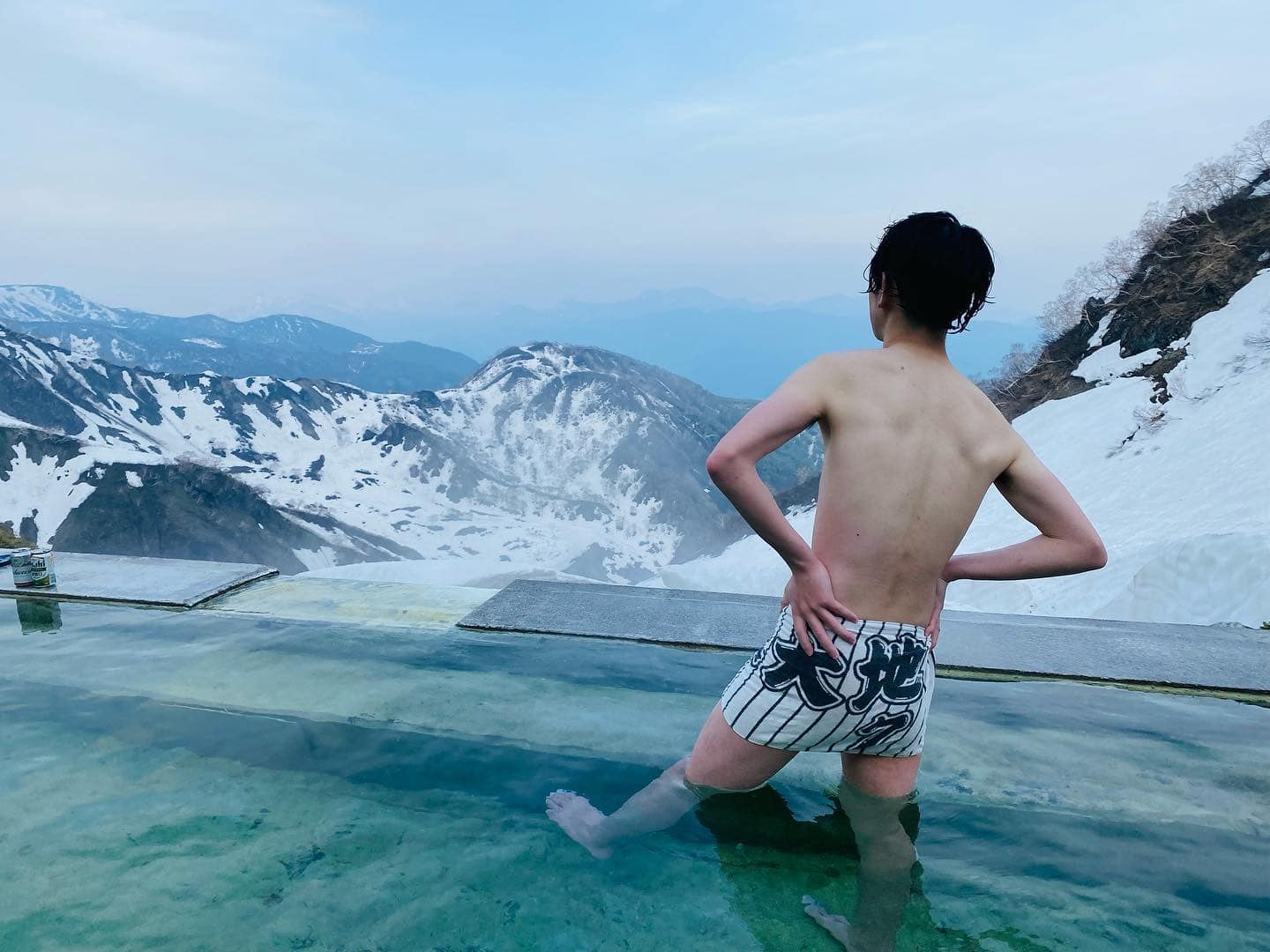
Among the world-renowned mountain landscapes of Japan, there is a place that stands out for its exceptional beauty, challenging terrain, and the promise of an unforgettable experience. This is the "Hakuba Sanzan" (Three Peaks of Hakuba), comprising Mt. Hakuba (Shirouma-dake), Mt. Shakushi (Shakushi-dake), and Mt. Yarigatake (Hakuba Yarigatake), towering over Hakuba Village in Nagano Prefecture. The circuit route that traverses these three majestic peaks, crosses the Hakuba Daisekkei (Great Snow Valley)—one of Japan's three great snow valleys—and even includes a visit to the secluded Hakuba Yari Onsen (hot spring) nestled deep in the mountains, is renowned as a "Golden Course" that encapsulates the grandeur and diverse landscapes of the Northern Alps.
My own experience on this Hakuba Sanzan traverse took place in late April 2023, during the residual snow season. What made it particularly memorable was stepping into the gleaming silver mountains on the very day the Prefectural Road Hakuba-dake Line (Futamata to Sarukura section) opened.The freshly fallen snow, blanketing the ridges in a pristine white, offered a serene and majestic beauty distinct from the summer bustle. I navigated this silver world with crampons and an ice axe, at times overcoming the danger of rolling snowballs, some as large as 80cm in diameter , and finally reached a sky-high hot spring to enjoy a snow-viewing bath. It was more than just a hike; it was an adventure that allowed me to experience the very "soul" of Japan's mountains with all my senses.In this article, I will share the unparalleled charm of my Hakuba Sanzan traverse during the residual snow season and highlight the experiences one can have there.
Contents
The Unparalleled Charm of the Hakuba Sanzan Traverse in Residual Snow: Silver Ridges and Nature's Art
The Hakuba Sanzan traverse in the residual snow season is not merely about climbing mountains. It's an immersive journey where nature unfolds its artistry, stimulating all your senses and stirring your soul.
The Overwhelming Power of Hakuba Daisekkei and the Baptism of Snow Mountains
The initial part of this route features the awe-inspiring Hakuba Daisekkei (Great Snow Valley), one of Japan's three great snow valleys. In late April, the snow valley is completely covered in snow, captivating visitors with its immense scale.The unique experience of ascending a snow valley is rare in other Japanese mountain ranges, and its grandeur is truly a natural wonder. However, beneath its beauty lie dangers such as falling rocks and avalanches , making essential winter mountain gear like a helmet, front-crampons (with at least 10 points), and an ice axe a must.Light crampons or chain spikes are unsuitable and not recommended due to the risk of slipping.
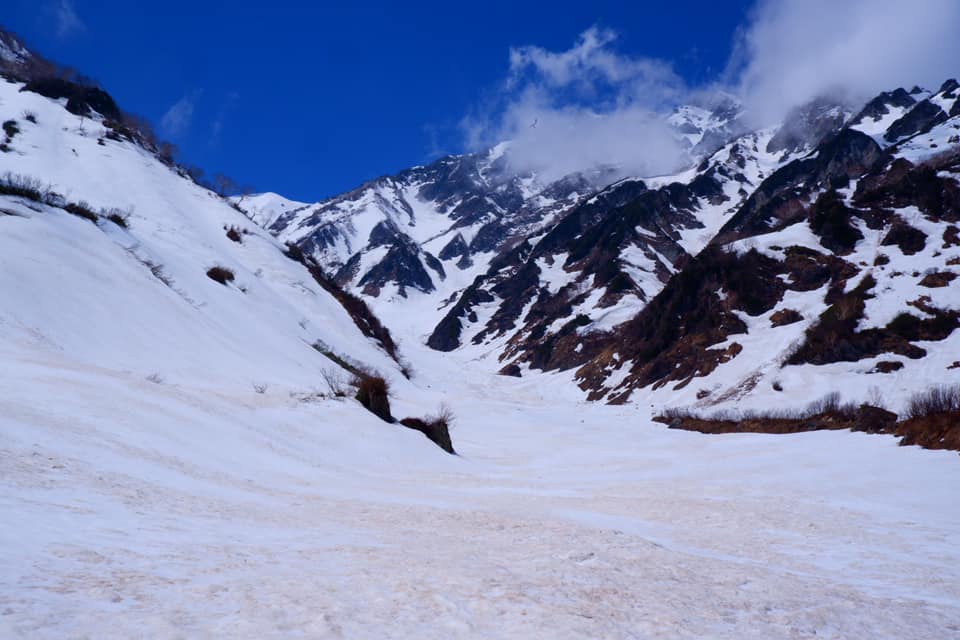
Walking the Silver Cloud-Kissed Ridges and the Breath of Life
After traversing the Hakuba Daisekkei, you embark on a journey along the silver cloud-kissed ridges. The ridge line extending from Mt. Hakuba to Mt. Shakushi and Mt. Yarigatake is still covered in snow, offering a profound sense of height and openness, making you feel as if you are walking above the clouds.While the summer alpine flower fields are still buried under snow, in areas where the snowmelt is progressing, delicate early spring flowers may begin to emerge. If you're lucky, you might even encounter the rock ptarmigan, a special natural monument endemic to Japan.
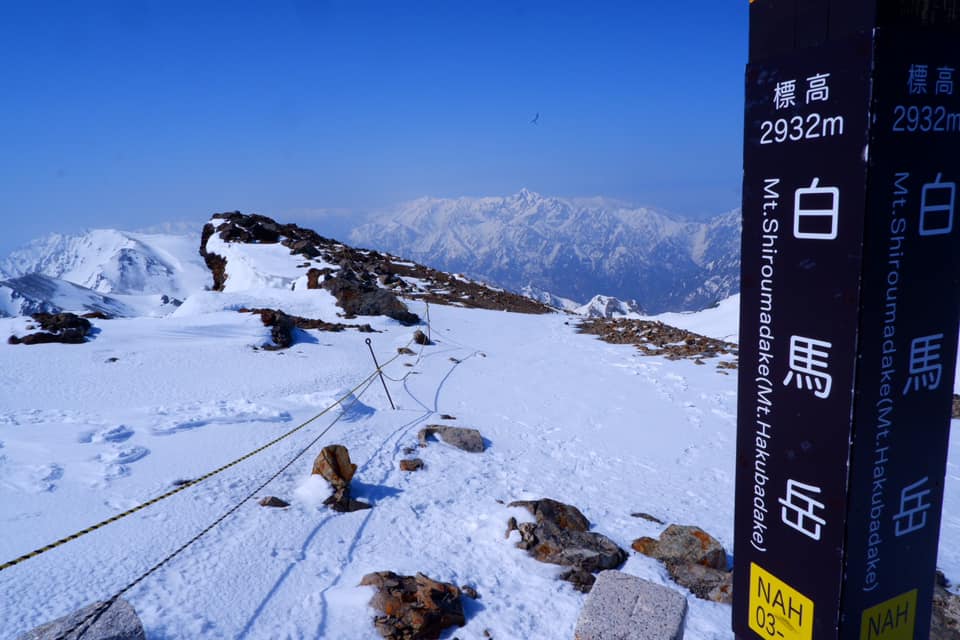
A 360-Degree Panorama and a World of Pure White
Standing on the summit, a 360-degree panorama unfolds before your eyes. Beyond the majestic peaks of the Northern Alps, you can gaze upon the Tateyama Mountain Range, Mt. Tsurugi, and even distant views of Mt. Fuji and the Sea of Japan—a truly spectacular sight.The mountains, dyed pure white in the residual snow season, are breathtakingly beautiful. The sunrise painting the sky, the mountains bathed in the glow of sunset, and the sea of clouds stretching beneath your feet will be special experiences only found on this traverse.
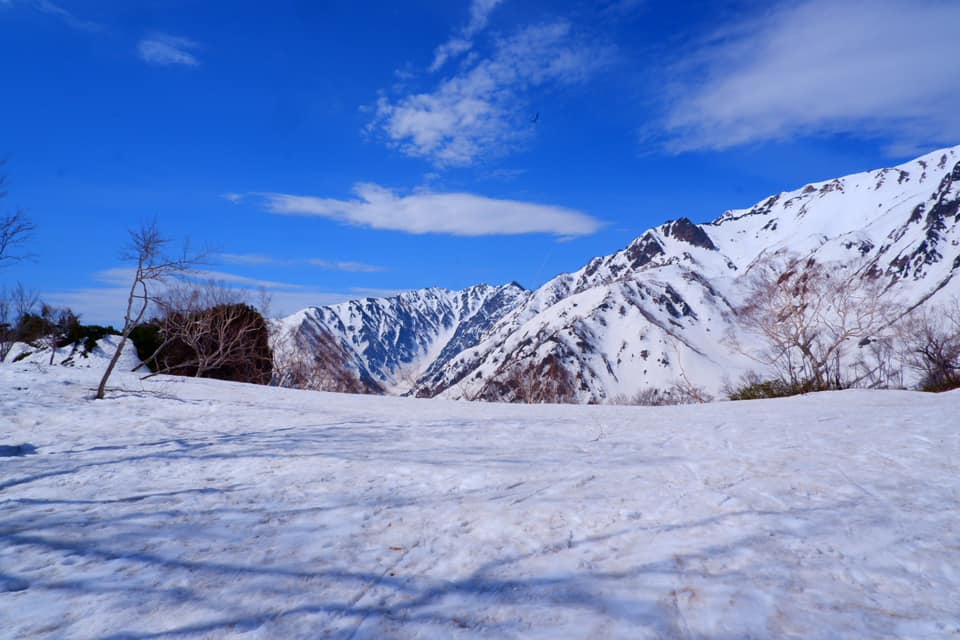
Three Distinctive Peaks
The Hakuba Sanzan each possess their own unique character. There's the grand and imposing Mt. Hakuba (Shirouma-dake) (elevation 2,932m) , the sharply pointed rocky peak of Mt. Shakushi (Shakushi-dake) (elevation 2,812m) , and the sturdy and dignified Mt. Yarigatake (Hakuba Yarigatake) (elevation 2,903m).In the residual snow season, these mountains are adorned with a blanket of snow, further accentuating their individual personalities.
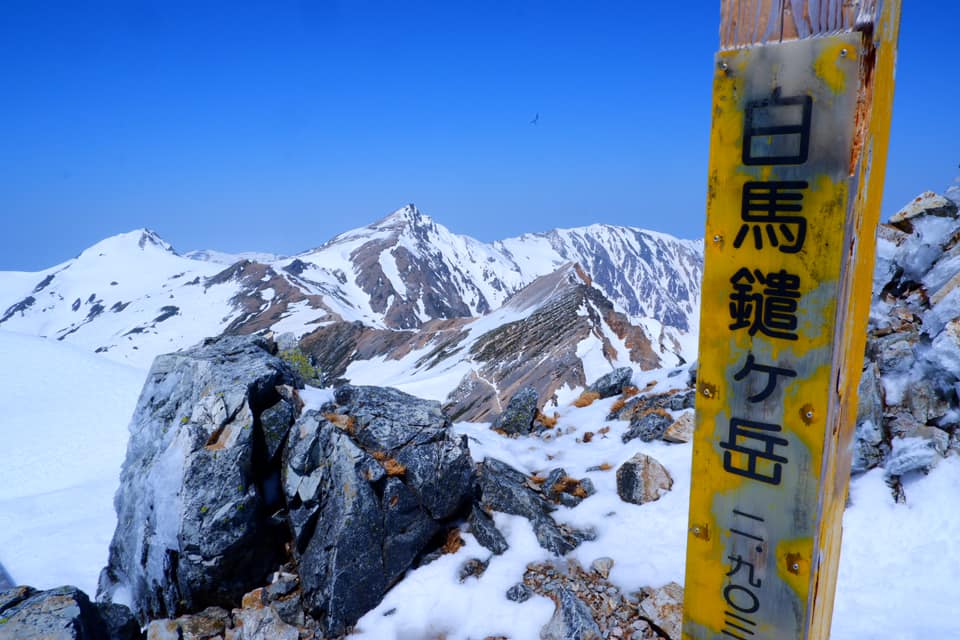
The Secret Hot Spring Experience at Hakuba Yari Onsen: The True Delight of a Snow-Viewing Bath
One of the highlights of this route is the Hakuba Yari Onsen, a natural hot spring bubbling up at an altitude of 2,100m in the heart of the mountains.In late April, the Hakuba Yari Onsen Hut is not yet open (in 2023, it operated from July 1st to September 30th) , but the rustic open-air bath is surrounded by snow, offering the true delight of a snow-viewing bath.I pitched my tent on a small concrete flat area next to this rustic open-air bath and spent the night there. This concrete section was only large enough for about two single-person tents. Soaking in a natural hot spring in a place only accessible to climbers is exceptional, soothing your tired body and soul.While soap and shampoo cannot be used, the wildness of this secret hot spring is its true essence.However, in the residual snow season, the approach to the hot spring is also covered in snow, and there is a risk of rolling snowballs, so extreme caution is required.
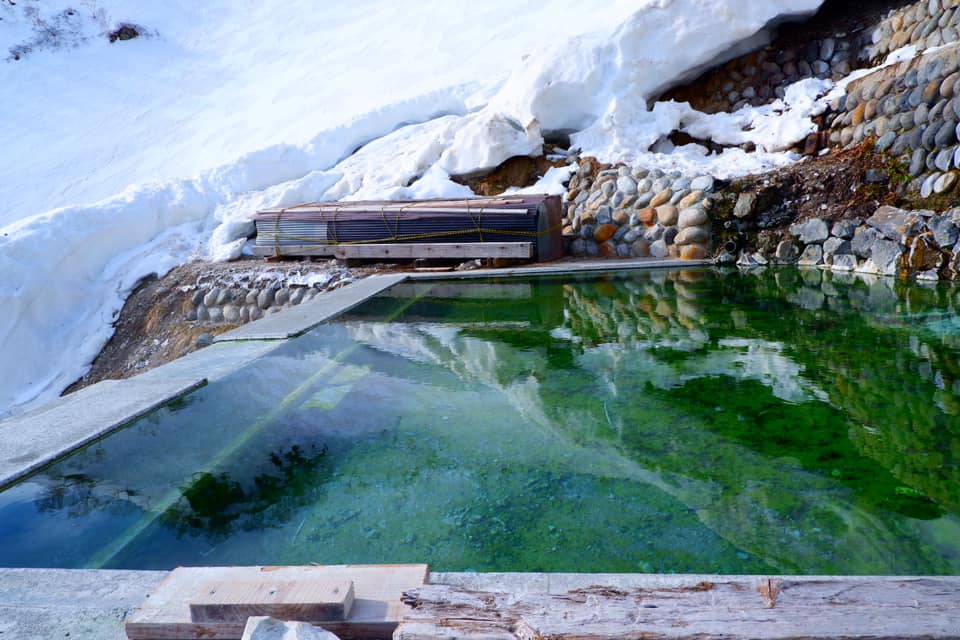
Experiencing Mountain Hut Culture in Residual Snow
During the residual snow season, many mountain huts are still closed for winter or operate only for a limited period during Golden Week.In late April 2023, Hakuba Sanso began its operations on April 29th , but Hakuba Yari Onsen Hut was not yet open.Therefore, accommodation planning is crucial. Staying at an open mountain hut offers warm meals and a sky full of stars.The camaraderie among fellow climbers helps you forget your fatigue and creates lasting memories. Mountain huts operate on a strict reservation-only basis, so advance booking is essential.
Hakuba Sanzan Traverse 2-Night, 3-Day Trek Details in Residual Snow: Itinerary and Experience Highlights
Given its scale and challenging nature, the circuit route encompassing the Hakuba Sanzan and Hakuba Yari Onsen is generally recommended as a 2-night, 3-day itinerary.Even for experienced winter mountaineers, the hiking time tends to be longer than in summer, making a plan with ample leeway essential. Here, I will introduce a typical 2-night, 3-day model itinerary starting and ending at Sarukura.Table 1: Hakuba Sanzan & Hakuba Yari Onsen Circuit Route 2-Night, 3-Day Model Itinerary (Sarukura Start/End)
Day | Section | Estimated Hiking Time | Elevation (Pass/Stay) | Accommodation/Rest Stop | Special Notes |
Day 1 | Sarukura → Hakuba Daisekkei → Hakuba Sanso | Approx. 7-8 hours | Sarukura (1250m) → Hakuba Sanso (2832m) | Hakuba Sanso | Hakuba Daisekkei is entirely snow-covered. Extreme caution for falling rocks, crevasses, and avalanches. Helmet, front-crampons, ice axe essential.Avoid long breaks.Don't rest immediately upon arrival to prevent altitude sickness. |
Day 2 | Hakuba Sanso → Mt. Shakushi → Mt. Yarigatake → Hakuba Yari Onsen (Wild Hot Spring) | Approx. 5-6 hours | Hakuba Sanso (2832m) → Mt. Shakushi (2812m) → Mt. Yarigatake (2903m) → Hakuba Yari Onsen (2100m) | Tent camping on concrete flat area next to Hakuba Yari Onsen (Wild Hot Spring) | Hakuba Sanzan traverse is snow-covered. Beware of cornices on ridges. Hakuba Yari Onsen Hut is closed.Approach to hot spring is on snow; beware of rolling snowballs. |
Day 3 | Around Hakuba Yari Onsen → Sarukura | Approx. 4 hours | Hakuba Yari Onsen (2100m) → Kohinata-no-Koru → Sarukura (1250m) | None | Crossing streams with frequent rockfalls, similar to residual snow season. Route finding essential as snow can make paths unclear. |
Highlights of Each Major Point
Sarukura / Happo-one: In late April 2023, the Prefectural Road Hakuba-dake Line (Futamata to Sarukura section) had just opened.I was able to drive my private car all the way to Sarukura on that opening day. Typically, route buses operate from July onwards , so during this period, one would usually park in the Happo Bus Terminal area and approach the Sarukura trailhead on foot along the newly opened road or by taxi.
Hakuba Daisekkei: Walking on the magnificent, entirely snow-covered snow valley is iconic for this route. However, the risk of falling rocks, crevasses, and avalanches is very high, making a helmet, front-crampons (with at least 10 points), and an ice axe essential gear. Be constantly aware of your surroundings and avoid long breaks.
Mt. Hakuba Summit: From the expansive summit, you can enjoy a 360-degree panoramic view of the majestic Northern Alps. The pure white scenery unique to the residual snow season will make the sense of accomplishment here even more special.
Traverse to Mt. Shakushi and Mt. Yarigatake: The ridge line extending from Mt. Hakuba offers breathtaking views and a feeling of openness. However, the summer trail is buried under snow, so caution is needed for cornices and hidden crevasses. Some sections include rocky areas and chains, requiring careful footing.
Hakuba Yari Onsen (Wild Hot Spring): Located at an altitude of 2,100m, this hot spring's hut is closed during the residual snow season , but the rustic open-air bath may be accessible. Soaking in the hot spring surrounded by snow will be the ultimate luxury to soothe your tired body.I pitched my tent on a small concrete flat area next to this hot spring and spent the night there. This concrete section was only large enough for about two single-person tents. However, the approach to the hot spring is also on snow, and there are dangers such as rolling snowballs, so extreme caution is required.
Descent Route: The descent route from Hakuba Yari Onsen, even in the residual snow season, includes sections with frequent rockfalls and unclear paths, so you must remain vigilant until the very end.Being covered in snow can make route finding more challenging than in summer.
Physical and Mental Challenges
This 2-night, 3-day traverse, due to its nature as a residual snow climb, presents significant physical and mental challenges. Walking on snow consumes more energy than summer hiking, and the ability to cope with low temperatures and sudden weather changes (such as whiteouts) is also required.However, the sense of accomplishment gained from overcoming difficult sections, and the judgment and adaptability developed in response to the harsh high-mountain environment, will help you grow into a stronger, more confident climber.
Tips and Precautions for Your Visit
When planning a Hakuba Sanzan traverse during the residual snow season, there are important tips and precautions you should be aware of.
Best Season (Residual Snow)
Late April to Early May (Golden Week period): This is the most beautiful time when the mountains are covered in silver, and the Daisekkei is entirely snow-covered.However, the risk of avalanches is high during this period , and sudden weather changes are frequent, so sufficient winter mountaineering experience and equipment are essential.
Required Equipment
This route is a serious winter mountain traverse, so the following equipment is essential or strongly recommended:
Front-crampons (10 points or more) and an ice axe: Essential as the entire route, including Hakuba Daisekkei, is covered in snow.Light crampons or chain spikes are unsuitable.
Helmet: Essential for sections with falling rocks, such as Hakuba Daisekkei.
Highly Waterproof Rainwear (Jacket and Pants Essential): Gore-Tex or similar waterproof-breathable materials are ideal.Also crucial for wind and cold protection.
Sturdy Winter Mountaineering Boots: Essential for winter conditions, with good insulation and waterproofing. Check for sole separation before departure.
Warm Clothing: Fleece, down jacket, etc., capable of handling near-winter low temperatures (which can drop below freezing near the summit).Change wet clothes immediately.
Gloves, Sunglasses, Sunscreen, Hat: For UV protection (essential due to strong reflection from snow) and cold weather.Waterproof gloves are also necessary.
Backpack, Headlamp (with spare batteries), Food, Water: Bring sufficient quantities.
Map and GPS: Carry a paper map and a GPS device (including spare batteries) to confirm your current location even in areas without signal.This is especially important as snow can make routes unclear.
Emergency Gear: Bivouac sack (zelt), first-aid kit, avalanche beacon, probe, and shovel, etc., for emergencies.
Mountain Hut Reservations
During the residual snow season, only a few mountain huts, such as Hakuba Sanso, operate during the Golden Week period, while Hakuba Yari Onsen Hut is closed.All mountain huts you plan to stay at require complete reservations.Especially during weekends and peak seasons, bookings can fill up quickly, so early reservation is essential.
Physical Fitness and Experience
This route is a serious winter mountain climb, requiring advanced experience and physical fitness.Experience with snow travel, chains, ladders, rocky sections, and snowfield walking is necessary, as is the ability to assess avalanche terrain and perform route finding. Sufficient physical fitness and concentration are required, so prior training is recommended.
Safety Measures
Beware of Sudden Weather Changes: Mountain weather is unpredictable, and during the residual snow season, sudden changes can lead to whiteouts or thunderstorms.If visibility deteriorates due to fog, proceed by confirming trail markers and ensure you have a good understanding of the route from your map beforehand.
Lightning Safety: If a lightning warning is issued or thunder is heard, quickly move away from ridges to a safe location like a mountain hut.
Submit a Climbing Plan: In Nagano Prefecture, submitting a climbing plan is mandatory.Online systems like YAMAP and Compass are convenient for this.
Solo Hiking is Extremely Dangerous: The residual snow season significantly increases the danger, so it is highly recommended to hike with an experienced companion.
Always Watch for Falling Rocks, Avalanches, and Crevasses: Exercise extreme caution, especially in Hakuba Daisekkei and around Hakuba Yari Onsen, due to falling rocks, avalanches, and hidden crevasses.
Conclusion
The Hakuba Sanzan traverse in Hakuba Village, Nagano Prefecture, transforms into the ultimate adventure when visited during the residual snow season, as Japan's representative mountain scenery is dyed in silver. The grandeur of Hakuba Daisekkei, the 360-degree panorama from the silver ridges, and the snow-viewing bath at the secret hot spring of Hakuba Yari Onsen will be deeply etched in your memory.Why not embark on an adventure to witness breathtaking views and achieve an unforgettable sense of accomplishment in the heart of the Japanese Alps?